#sci fi thriller with dinosaurs and protecting a little girl
Explore tagged Tumblr posts
Note
65 trailer has come out
It looks so good!!!!
#ask#anonymous#adam driver#65#I've enjoyed all his movies the last few years#but THIS#this is what I've been waiting for!!#sci fi thriller with dinosaurs and protecting a little girl#I'm all in#I can't wait!!#and releasing the trailer on the 5 year anniversary of tlj#😊
4 notes
·
View notes
Text
Film Review - Jurassic Park (1993)
Jurassic Park isn’t just a science fiction thriller. It’s a marvel of innovation in film production. The special effects were groundbreaking for the time and are still better, in my opinion, than a lot of the CGI that has come since. The soundtrack is inspiring and nostalgic, and I knew it before I saw the movie because my mother liked the music so much. This being said, you can have the most sophisticated special effects and most visually attractive film in the world, but it will not have a lasting cultural impact without a good story and characters. At the same time, even the most compelling characters and highest stakes will fade without an element that sets them apart from all the other action movies. Jurassic Park exists in the best of both worlds, with a captivating story wrapped in a beautiful package.
Let’s start with the high concept. A theme park of dinosaurs. Dinosaurs. Everyone and their kids love dinosaurs. Would a story about a park that resurrects the early ancestors of mammals be as popular? Probably not. In this style of science fiction, the larger than life and the further removed from our current state of scientific advancement, the better. The film starts out with a strong sense of wonder to draw in the audience’s attention and get them excited about something that really is a long stretch of exposition and worldbuilding. The moment when the music swells and the animals are revealed— “They do move in herds.” —is something burned into the memory of everyone who’s seen the movie.
And then a flip is switched, literally—Wayne Knight’s character (whom I can only think of as Newman despite this being a completely different thing) shuts off the power—and the tone turns from whimsical adventure to survival horror. The stakes are high and just keep getting higher. The hurricane. The power outage. The computer system lockout. Then all the hunter dinosaurs have been evaded, and people can breathe—but then the velociraptors escape and form the final stakes and climax. Despite losses and injuries, the main characters survive and get off the island. The heart of the film is the characters. Several are larger than life: the billionaire Hammond, the dinosaur hunter, and the smart AND heroic duo of Dr. Grant and Dr. Sattler. These characters, their skills and feats, and the speculative elements they represent are grounded into our world by the presence of the two children. The adults give up their money or safety to protect the children, and as the children are taught about the dinosaurs they see, the audience learns too. A necessary human element and emotional motivation is added to balance the thrills and physical dangers.
I have to mention the relevance of Jurassic Park to women in STEM. I’d hope this is a reason for its enduring beloved place in pop culture; it’s certainly a reason I like it more than other sci-fi thrillers. Ellie is just as competent as her male peers and even more willing to get dirty in the field. The little girl is the computer whiz. Jeff Goldblum’s character has the damsel in distress trope with the injury and the torn open shirt.
“God creates dinosaurs. God destroys dinosaurs. God creates man, man destroys God, man creates dinosaurs.” “Dinosaurs eat man... woman inherits the earth.”
As my favorite quote in the movie illustrates, order is broken and restored, and a safe environment for the audience to feel adrenaline and fear is maintained. It’s a satisfying thriller.
The superlative technical effects with the dinosaurs are at least half the reason for the film’s success, but if there wasn’t meaning below the animatronics, it wouldn’t have the impact it maintains in public consciousness. The dinosaurs aren’t just killing machines, they’re portrayed humanely as animals who’ve been stuck in an unsuitable environment, lashing out in boredom or simply fulfilling an environmental niche with no malice. The park fails because it’s operating for profit instead of concern for its animals or a genuine love of science. The heroes—paleontologists—serve as a foil to the greed that causes the plot problems.
Whenever you see a news report about a controversial (often, this means little understood) new area of research, especially in biology, someone inevitably brings up Jurassic Park as a warning. It’s synonymous for the theme of dangers of capitalism corrupting science. This has been a fear since the inception of the science fiction genre and continues to be relevant in our culture. Though the franchise has ironically expanded to a themed land at Universal Studios: Orlando, and its most recent Jurassic World series of sequels feels to have lost touch with the theme in favor of “let’s make a bunch of money with scary special effects and ignore the heart of the love of science.” A franchise either has a satisfying conclusion or keeps being extended long enough to become a parody of what it once meant, or something like that, at least according to me (let’s not get started on the Star Wars sequels and the butchering of the original trilogy’s theme of hope). To me, the original 1993 Jurassic Park remains the best, the quintessence of dinosaur movies. It carries the vital message that science is not the enemy but the creator of the grandeur in the opening of the film, and capitalist greed is the reason it becomes a deadly horror story. It is science that saves the characters and gives them the knowledge to survive and escape. As the film ends and the music swells once more, we see what joy and good science has achieved: a brave new world of animals saved from extinction.
3 notes
·
View notes
Text
LOCKDOWN READS 2020
It is no surprise that time people spent with books has doubled in the current “locked down” environment. This surge in reading across the world is more than a way to kill time rather is reflective and therapeutic. Personally, I’ve always favored thrillers and crime novels which is obvious in this featured list.
Sheldon, Sidney (1987) Windmills of the Gods
“If something seems to be too good to be true, Mary, it probably is.”
Mary Ashley, a young ambassadress married to a doctor named Edward, unexpectedly faces her plotted destruction in the middle of a global conspiracy.
This classic best-selling thriller will never disappoint with its thrills and spills from start to finish.
Sheldon, Sidney (1991) The Doomsday Conspiracy
“I’m tired of the lies and the cheating, and the broken promises that were never meant to be kept.”
This suspense-thriller novel revolves around an US Navy Commander, Robert Bellamy, who finds himself in the middle of an international conspiracy after being handpicked by the head of the NSA to track down and identify the ten unknown survivors of a weather balloon accident in the Swiss Alps.
With an easy-to-follow plot and great wicked twists that carry the readers on a luxury tour of Washington, this is definitely a page turner.
Pike, Christopher (1995) The Visitor
“All are doomed to love, all are doomed to die.”
Nope, it’s definitely not about Tom, the strange new boy in town, as the back of the book says, but instead it focuses on a story of many lives told through the eyes of Mary or Clareesh, who's engulfed in her grief and guilt over the death of her boyfriend, Jerry.
The writing style is twisted, but delightfully weird. Some stuff is brilliant, some is just bizarre. All in all, it’s a pretty groovy, high as a kite YA novel.
Pike, Christopher (1991) Die Softly
“He had smoked dope exactly twice, but stopped when he realized it was called dope for a reason.”
Herb Trasker, a senior in Alamo High who doesn't have much going for him except that he's a good photographer, decides to take pictures of cheerleaders as they shower in the gym locker room. He sets up his camera, sets the timer, and comes back to find out that he might have photographed a murder.
Definitely a dark and twisted thriller.
Pike, Christopher (1986) Weekend
“If I thought there was a chance, I would do it.”
A weekend of sun and fun in Acapulco turns into a nightmare when four guys and five girls are trapped in a luxury Oceanside mansion in Mexico and realize that they have been lured there for a deadly reason.
It is an excellent, entertaining, and swiftly moving thriller for older young adults who are a bit more worldly.
Pike, Christopher (1989) Scavenger Hunt
“Yes, a Jedi's strength flows from the Force. But beware of the dark side. Anger, fear, aggression; the dark side of the Force are they.”
With school nearly over, a secretive club on campus has organized a scavenger hunt for the whole senior class. The kids are led throughout the city and into the nighttime desert. Their goal is the wonderful prize promised to the winner. Soon, it transforms into a nightmare for Carl Timmons, a troubled young man weighed down by guilt and what ifs from his best friend's death, when he and his friends are lured a ruse by evil creatures from the time of the dinosaurs looking for their next victims.
This scavenger hunt from hell has a supernatural/sci-fi angle, an ending that is just beyond bizarre, and a weird spiritual angle which makes it worth the read.
Clark, Mary Higgins (2000) Before I Say Goodbye
“They use their little bit of authority on people like us who can't fight back. Expect it, Winifred. That's the kind of world it is.”
Nell McDermot probes into the mysterious circumstances of her husband's death when his private boat explodes. Thrown into a pit of grief, she seeks answers from a medium who claims to be his channel and has a message for her.
A host of characters keep the reader occupied and twists and turns galore in this gripping thriller. The plot was excellent and I was on the edge of my seat throughout the whole book. It is definitely a manna from heaven for suspense lovers.
Clark, Mary Higgins (1982) A Cry in the Night
"Please understand, Jenny," he'd begged. "Every artist needs a place to be totally alone."
Jenny MacPartland was a charming, divorced mother of two working at a New York art gallery whose struggle is not helped by her irresponsible ex-husband. Soon, she’s whisked away into a life of riches when she meets the man of her dreams, talented Erich Krueger. They marry quickly and Jenny plans a loving home on Erich's vast Minnesota farm but begins to notice his obsession with his dead mother.
This wonderfully creepy book story is filled with intrigue and mystery. This chilling portrait etched in terror proves that Clark is a real woman who loves her work and can't stop.
Clark, Mary Higgins (1997) Pretend You Don’t See Her
"The words refused to pass her lips. It was too late. Lacey could see that.”
The book, set in New York and in Minneapolis-St. Paul, is the story of Lacey Farrell, a young rising star on Manhattan's high-powered and competitive real estate scene. She becomes a witness to a murder and finds that what she's seen might make her the next casualty, putting her into the witness protection program.
It’s a mystery that's never easy to figure out and satisfying in the end. This book is no exception. Clark writes characters that I like - all of them - even the bad guys. My favorite part of this novel is that the ending is very unpredictable.
THE END
0 notes
Text
10 Things In Sci-Fi Movies You Didn't Know Were CGI | ScreenRant
From early pioneers like Tron and Terminator 2: Judgment Day, to game changers like Episode 1: The Phantom Menace and The Matrix trilogy, CGI has been used to augment the ideas and themes presented in science-fiction films. Science fiction as a genre provides different perspectives on how we think of everything from the future of our race, to the perils of technological advancement and the complexities of space travel. Computer graphic imagery and the advancements in that field help filmmakers realize their visions in ways that weren't possible with practical effects alone.
These days, CGI is more prevalent in science-fiction films than ever before. We're used to seeing the big spectacle of space battles in the latest Star Wars film. We've become accustomed to the exotic aliens of Star Trek films. But what about when CGI is used so subtly you don't even notice it? Or for things other than giant spaceships and strange extraterrestrials? Below you'll find ten things in sci-fi movies you didn't know were CGI.
10 Star Wars: The Force Awakens
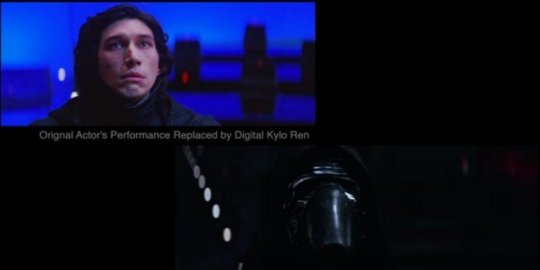
Sometimes the CGI in sci-fi films is used not for huge battles or giant creatures, but to fix mistakes or recreate common objects. CGI has become a staple in the latest Star Wars films, especially for obvious things like ships, planets, space. But it was also used rather subtly and to great effect in The Force Awakens.
RELATED: Star Wars: Kylo Ren's 10 Best Moments (So Far)
The dialogue between Supreme Leader Snoke and Kylo Ren about Ren really being Ben Solo, Han Solo's only son, was meant to be later on in the film. Therefore, it was filmed with Ren's helmet off. JJ Abrams decided the reveal should come sooner, and the scene had to be reshot, with a CGI mask placed over Adam Driver's face. You can't tell it isn't a real helmet.
9 Deus Ex Machina
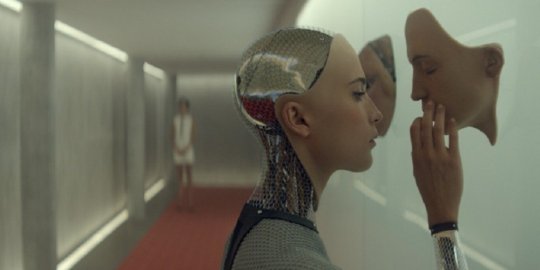
Deus Ex Machina is a genre film that relies more heavily on ideas than visual effects, as implied by the nature of its title, which implies a plot contrivance. Alicia Vikander stars as the cybernetic artificial intelligence unit that is created by the minds of a brilliant programmer and a Dr. Frankenstein-like engineer.
While in many scenes it appears Vikander is wearing some sort of suit that might simulate her cybernetic bodyform, she isn't. Only her face, hands, and feet are her own; everything else is CGI. It moves with such synchronicity to her own body movements as to appear virtually indistinguishable.
8 E.T.
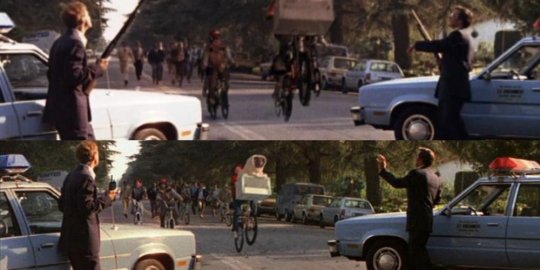
One of Spielberg's landmark films, E.T. didn't make a flashy use of CGI in 1982, with the renowned filmmaker electing to use puppetry and practical effects wherever possible (save of course for the iconic bicycles-to-the-moon-shot). All bets were off when it came to the 2002 DVD release, however.
RELATED: Steven Spielberg's 10 Best Movies, According To Rotten Tomatoes
Spielberg had often said that if he could go back and "fix" anything in the film, it would be the guns used by the police who go after the escaping kids. He felt it was distasteful for officers of the law to draw weapons on children, and used CGI to swap the guns for walkie-talkies.
7 Jurassic Park
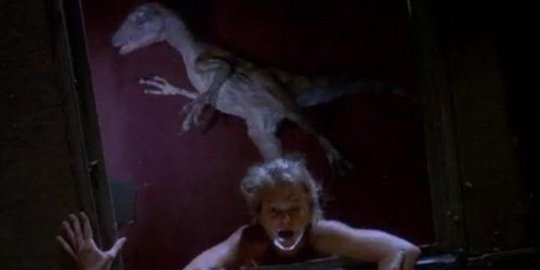
Jurassic Park is known for pioneering some incredible CGI effects, many of them the result of blending techniques used in stop-motion film making with modern innovations in computer graphic design. But the dinosaurs weren't the only things being rendered that way.
In the scene where Dr. Grant, Dr. Sattler, and John Hammond's grandchildren are forced to escape into the air ducts of the Visitor's Center, Lex nearly plunges to her doom. The moment where she nearly falls from the edge of the duct to the hungry velociraptor below featured a stunt girl that inadvertently looked into the camera. CGI had to be used to put the actress's face over hers rather than reshoot the scene.
6 War For The Planet Of The Apes
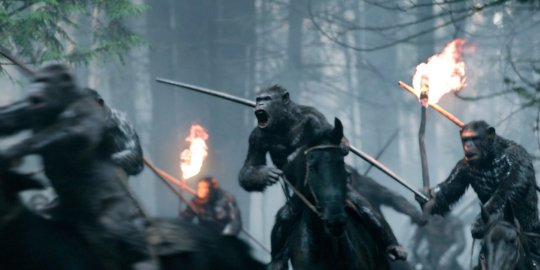
While audiences know that the talking bipedal apes featured in the new Planet of the Apes trilogy aren't real (and also not all played by Andy Serkis), they may not know how CGI is utilized in the rest of the films. Some of the most impressive uses of it are featured in the third film, War for the Planet of the Apes.
While CGI specialists were busy using programs to individually create strands of ape hair, they were also using them to create individual droplets of water, and leaves on trees. A great deal of the forest the apes used as their hideout area, as well as the terrain featured during the battle sequences, was entirely made of CGI despite looking incredibly life-like.
5 Children Of Men
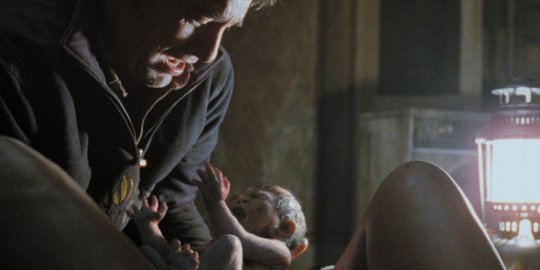
Children of Men was a universally celebrated sci-fi movie when it debuted, in large part due to its visceral vision of a dystopian future. In a time when children aren't born due to infertility reasons, one man must protect the last child of humankind and defend it from a myriad of dangers.
RELATED: 10 Sci-Fi Movies To Watch If You Like Children Of Men
The last baby that Clive Owen's character protects wasn't a real baby at all due to the hazardous nature of the scenes it was featured in (especially him running and jumping across rooftops or amidst gunfire). Therefore it was necessary to use a CGI baby that's so life-like it fooled audiences completely.
4 Indiana Jones And The Kingdom Of The Crystal Skull
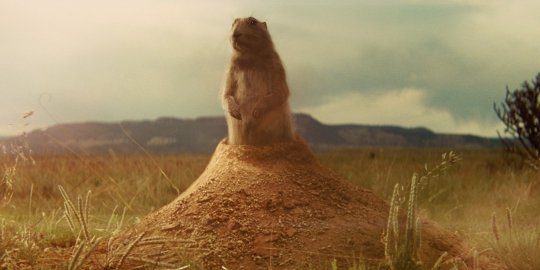
While most wouldn't classify Indiana Jones and the Kingdom of the Crystal Skull as a sci-fi film, the ending would solidly place it in that category. It features the beginning of the Atomic Age, and positions Indy in a world that's beginning to become completely immersed in what lies among the stars.
RELATED: Indiana Jones 5: 10 Scrapped Ideas From Previous Sequels It Should Use
In the opening sequence involving two hot-rods racing (a 1950 Ford Deluxe Army Staff Car vs a 1932 Ford Model B Roadster), one of them rides over a gopher hole. The little critter almost gets himself decapitated by the Model B, before scampering off. That gopher was entirely CGI...for some reason.
3 Waterworld
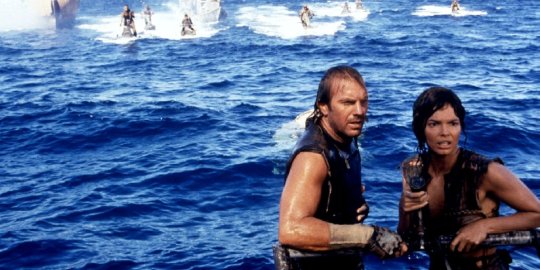
Waterworld was an ambitious project, some would say too ambitious for a sci-fi film. It was plagued by every conceivable problem on set, had an incredibly bloated budget, problems filming on oceanic locations, as well as hazardous working conditions. It also spent a hundred thousand dollars on making the ocean CGI.
Despite the fact that aerial shots exist, there are scenes in Waterworld where the ocean is CGI, and while it looks fantastic, this contrasts pretty spectacularly with shots of the real thing. This is why the budget ballooned from $100 million to $175 million.
2 Supernova
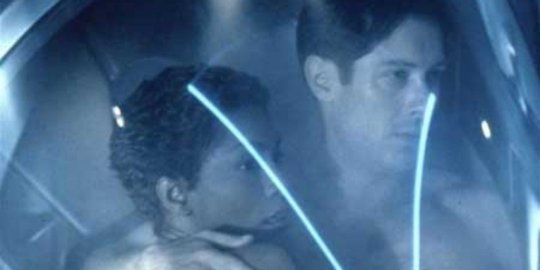
It's General Hospital, in space! Or it's Supernova, a sci-fi thriller that positions a hospital ship in deep space. Their continuing mission? To answer intergalactic 911 calls. When the Nightingale 229 answers a distress call from another ship, the survivor they bring on board and his alien artifact may trigger a supernova that will wipe out the galaxy.
RELATED: 10 Weirdest Places That Movie Characters Have Sex
Before that catastrophic event happens, there's time for a little hanky-panky. In zero gravity, Angela Bassett and James Spader's character have a sex scene, except they weren't on set to do it. It's really their co-stars, Peter Facinelli and Robin Tunney, with Tunney's skin tone altered in post-production to match Bassett's.
1 Return Of The Jedi
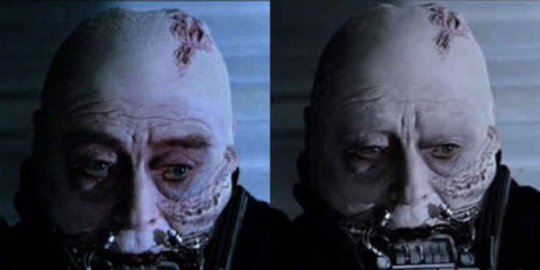
While some Star Wars fans found things to gripe about in the original trilogy's third installment it was, on the whole, a fitting climax to one of the most beloved saga's in sci-fi history. George Lucas would later come out with a trilogy of prequels for Star Wars fans to complain about and, armed with new advancements in CGI, he would go back and alter their beloved film. If you've never seen any other version of the film, you may think the alterations were normal.
When Luke takes Vader's mask off so he can see his son with his own eyes, we see that Vader has no eyebrows in the 2004 Blu-Ray edition. This is because Lucas felt they should've been burned off on Mustafar where he sustained the injuries that put him in the mask to begin with, so CGI was used to remove them. Too bad he didn't stop there...
NEXT: 10 Amazing Movie Scenes That Did Not Use CGI
source https://screenrant.com/sci-fi-movies-cgi-surprise/
0 notes